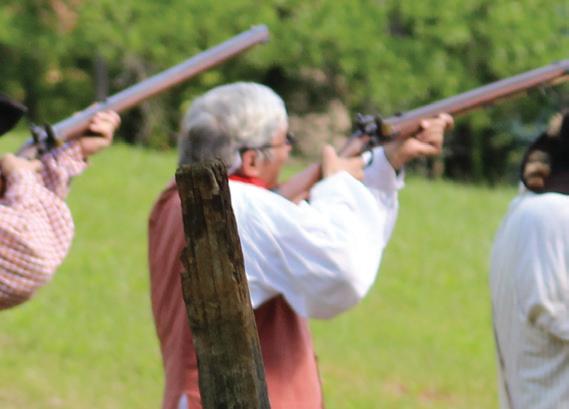









Easy to use.
Easy to get help.



















Jitterbug® phones feature large screens with big text, simple menus with effortless navigation, powerful speakers and Urgent Response buttons. The Jitterbug® Flip2 has big buttons with one-touch speed dialing, while the Jitterbug® Smart4 comes with voice typing, video chat and internet access.
Whether you want to learn more about your phone, need a ride or have a health concern, our 100% U.S.based team is here to help, day or night. And when you add Urgent Response, enjoy peace of mind knowing you can count on us 24/7, even in an emergency.
• Fast, reliable nationwide
• No long-term contracts
• No cancellation fees
• Keep your phone number2










Cooperative
mpd.coop
OFFICE LOCATIONS
1301 E. Pocket Road
P.O. Box 100561 Florence, SC 29502
843-665-4070
676 Highway 9 East
P.O. Box 1057
Bennettsville, SC 29512
843-479-3855
REPORT POWER OUTAGES
866-747-0060
OFFICE HOURS
8 a.m. to 5 p.m. Monday through Friday
PRESIDENT/CEO
William L. Fleming Jr.
BOARD OF TRUSTEES
John Alford
Melvin Carabo
Preston Gainey
James Goodson
Eddie Gordon
David Howell
Sam P. “Bo” McInnis Jr., Chairman
Robert Norton
Hamer Parnell
Jeff Quick, Secretary
Ronald “Ronnie” Quick
Janelle Sauls
LaShon Sellers, Vice Chairman
Charles R. “Ricky” Smith
Don R. Teal
Patricia Ann Toney
Lee C. White
CO-OP NEWS EDITORS
Katie W. Wilcox, CCC email: kwilcox@mpd.coop
Matt Haynie email: mhaynie@mpd.coop
MISSION STATEMENT
Our mission is to serve the energy needs of our members today and in the future at the lowest cost consistent with sound economic principles and management.
MPD Electric Cooperative Inc. is an equal opportunity provider and employer.
“Summertime, and the livin’ is easy.”
A famous song lyric written in the 1930s embodies the carefree nature of summer we still long for in today’s modern society. Summer is usually the time of year we can slow down a bit. Children are out of school, football season hasn’t quite begun, and the thought of Christmas shopping is too far in the future. This is the time of year we schedule family get-togethers and catch up with loved ones to tell stories, eat and laugh.
Each year, my family would spend a week at a Rocky Bottom, South Carolina, cabin that belonged to my grandmother’s family. It was at the end of Laurel Valley Road, and you had to cross multiple creeks and bridges to get there. Behind the house were woods and another creek we would walk down for miles to get to the waterfall at the end. Grandma had six children and 19 grandchildren, and most of them would come to visit at some point during that week right before school resumed.
My cousins and I would mostly hang out around the house, making mischief and exploring the outdoors. However, it was tradition each year that we would take a day trip to Maggie Valley, North Carolina, to visit the Ghost Town in the Sky amusement park.
The family trip wasn’t glamorous, but the time we spent together each summer sealed the friendships in our family for the rest of our lives.
This summer, relax, enjoy and make memories you’ll look back on with fondness and adoration.
RICKY SMITH Trustee

CEO Michael Shepard
SENIOR VICE PRESIDENT OF CONTENT
Leon Espinoza
EDITORIAL DIRECTOR
Chasity Anderson, CCC
SC CURRENTS EDITORS
Jennifer Paton, CCC
Valeri Saldanha Rosa
ASSISTANT EDITORS
Victoria Hampton, CCC
David Herder, CCC
Sable Riley, CCC
ASSOCIATE EDITOR
Nina Todea
SENIOR MANAGER, PUBLICATIONS PRODUCTION
Elizabeth Beatty
SENIOR PUBLICATIONS COORDINATOR
Alyssa McDougle
South Carolina Currents (issue 74) is published monthly, except in December, by Pioneer Utility Resources, 5625 NE Elam Young Pkwy. Ste. 100, Hillsboro, OR 97124. Preferred periodical postage permit number 23830 paid at Hillsboro, Oregon 97123 and additional mailing offices.
POSTMASTER: Send address changes to: South Carolina Currents, 5625 NE Elam Young Pkwy. Ste. 100, Hillsboro, OR 97124. Subscription price of $9.89 per year includes postage.
HOW TO CONTACT CURRENTS
Have a problem receiving your edition of South Carolina Currents? Utility members should contact MPD Electric Cooperative. Reprint permission: Direct all requests to Pioneer Utility Resources.
MANUSCRIPTS AND PHOTOGRAPHS
Please do not send unsolicited materials. If interested in writing for South Carolina Currents, query first. Include a selfaddressed stamped envelope for writers’ guidelines. Address requests and queries to Pioneer Utility Resources.
DISPLAY ADVERTISING INQUIRIES
American MainStreet Publications 611 S. Congress Ave. Ste. 504 Austin, TX 78704 800-626-1181 or 512-441-5200
© 2025 Pioneer Utility Resources. All rights reserved. Reproduction in whole or in part without written permission is prohibited.
Willie Wiredhand is the longtime mascot and spokesplug of electric cooperatives around the United States. He was adopted in 1951 by the National Rural Electric Cooperative Association. Here’s your task: Willie is hidden somewhere in every issue of Currents. See if you can find this friendly face among the news and stories as you read!






A Charleston tearoom classic makes a cool summer lunch Page 34 Page 12

“My










































Bakeshop’s confections keep customers coming back for more
By Jodi Helmer





































Most mornings, Katie Skeen is in the kitchen mixing flour, sugar, eggs and butter, and putting trays of pastries into the oven before the sun rises.
When Palmetto Bakeshop opens at 10 a.m., the pastry cases are filled with croissants, macarons, cinnamon rolls, eclairs and other fresh pastries, and there is often a line of customers outside, eager to satisfy their sweet tooth.

“The first time I ever walked out to the front of the bakery and saw the line out the door, I turned around and came back and cried,” Katie says. “I was thinking, ‘Oh my gosh, people really do like it!’ It was very humbling.”
A Hobby Becomes a Business Katie, owner and baker at Palmetto
Bakeshop, didn’t set out to run her own bakery. In fact, she spent much of her earlier career as a nurse. But what started as a hobby decorating cookies while raising her kids evolved into a full-blown pastry operation known for its small-batch, European-style offerings.
“I’ve always baked just for fun,” Katie says. “When the kids were little, I started making cakes and cookies and it just kind of took off. I never thought it would become anything more than that.”



In 2020, as the COVID-19 pandemic upended routines and normalcy, Katie turned to the kitchen in a different way. Frustrated by the uncertainty and searching for a creative outlet, she enrolled in virtual pastry classes with a European pastry chef teaching over Zoom.
“Everybody was making sourdough, so I decided to learn croissants,” she says. “It was one-on-one and just something I’d always wanted to do. It was just fun, but I never had the intention of doing anything with it or for it to evolve into a bakeshop.”
That quiet experimentation eventually bloomed into wholesale baking for local restaurants. With a push from her husband—and support of her daughter, who designed the bakery’s logo and manages its website and social media— Ashley opened Palmetto Bakeshop in June 2023.


The bakeshop is open just three days a week, four hours each day. The limited schedule is intentional. It allows Katie to focus on quality and freshness. She and her small team prepare all pastries in advance.
















“We only make enough for the day,” she says. “If we sell out, we close the doors and start fresh the next morning. I think people appreciate knowing that everything is made that day.”
Staple flavors like almond, pistachio, ham and Swiss, and bacon and cheddar croissants anchor the menu while seasonal fruit pastries rotate depending on what’s fresh and available. Katie sources ingredients like eggs and seasonal fruits locally whenever possible.


While Katie may have started without a formal plan, the bake shop has struck a chord with locals and transplants alike.
“There are people in Florence who’ve never had a fresh croissant,” she says. “But then there are folks who grew up traveling or lived abroad and they walk in and say, ‘This reminds me of that pastry shop I visited in Paris or Germany.’”
What began as a pandemic project grew into a community favorite, built on family support, trial and error, and a love for pastries. Despite her initial doubts, Katie
has found her rhythm—and her customers have found something truly special in Florence.
“I didn’t have the confidence at first,” she says. “But my family did. I’m just grateful people showed up and gave us a chance.”
Katie might be an experienced baker, but she steers clear of special-occasion cakes or elaborate custom confections.
“There are already so many places in town that do a better job at that than I can,” she says. “I just wanted to find something we didn’t have here—to come in and get fresh pastries.”
Focusing on European pastries has become Palmetto Bakeshop’s superpower.
Katie works with a small staff, and she wanted production to be intentional. It takes three days to make each batch of croissants. The labor-intensive process involves making dough and letting it rest, folding butter into the rested dough to
laminate it to form the signature flaky layers, putting it into a cold proofer overnight and cutting, rolling and baking the croissants.
“It’s hard to do in a production-type bakery,” Katie says. “It’s not financially sustainable in a big operation. But for us, it works.”
Katie didn’t go to pastry school, but she has taken countless classes where she learned to make everything from baguettes to eclairs. But the croissant is her cornerstone.


“I worked really hard to perfect the croissant,” she says. “And then kind of moved on from there.”
Multiple items in the pastry cases come from croissant dough. Katie uses it to make flaky Danishes, savory twists and croissant muffins—called cruffins—filled with pastry cream or fresh fruit. The tomato pesto Danish is a crowd favorite.
“It’s just a really versatile dough,” she says. “Sweet, savory, whatever we can do to make it fun and different.”






A Labor of Love
Though the bakeshop is open to the public only three days a week, Katie works five or six days every week and says there is never enough time to tackle all the items on her to-do list. She admits to being a bit of a perfectionist about her baked goods, especially when it comes to presentation.

“There’s this perception in my mind that everything should look photographworthy,” she says. “But I’m learning to let that go. Every croissant isn’t going to come out looking exactly the same—and that’s OK.”


wouldn’t have made it,” she says. “When you’re just making a dozen or so at home, you can take one hour, or you can take five hours. It doesn’t matter. But when you’re in a bakery and you have to do so many, you have to learn to get it done.”

“There’s one lady who brought me a thank-you note,” she recalls. “She had taken our pastries to someone in the hospital, and that woman wrote her a card just to say, ‘You made my day by walking in with that croissant.’ She brought it in to show me. I cried.”

It’s easy to forget that just a few years ago, Katie was baking croissants in her home kitchen. The leap to baking hundreds of croissants a day was only possible after working in other bakeries— places that taught her how to manage time, scale recipes and produce with consistency.
“It can be overwhelming. If I had gone straight from home to this, I probably

Planning inventory also demands constant mental math. Katie has to gauge how holidays, local events and college football games affect foot traffic. Palmetto Bakeshop is busier during special events like the Florence Wine and Food Festival and when Clemson University has away games. The football schedule has such an influence on demand for baked goods that Katie keeps it tacked on the wall to better anticipate the ebb and flow in the bakery.
Amid the hustle, the people who come through the doors keep her going. Palmetto Bakeshop has regulars who show up weekly for their favorite baked goods and newcomers who heard about the almond croissant from a co-worker. Katie even gets notes of gratitude from strangers.

When it comes to the future of Palmetto Bakeshop, Katie has no formal plans. Customers have suggested serving coffee or setting up tables for more of a cafe experience, but Katie prefers staying small to scaling up.
“I don’t know where we’ll be. In a year, I hope we’re still just doing what we do, taking it day by day,” she says. “I’m truly grateful every time somebody comes in and buys a croissant. I always say, ‘Measure with love.’ We want it to be a happy place where you can come in, get something good to eat and leave happy.”
Palmetto Bakeshop is open 10 a.m. to 2 p.m. Thursday to Saturday at 305 Rainbow Drive in Florence.

Every month, MPD Electric Cooperative features a new, recognizable spot from somewhere in the Pee Dee. Check out next month’s page for the answer.



This bell on display in Florence Veterans Park is from the World War I Dreadnought Battleship U.S.S. South Carolina, the third of four ships named after the Palmetto State. The battleship was in service from 1909 to 1921, with William Gilmer—who received the Navy Cross—in command of the ship. During World War I, the ship patrolled the East Coast of the United States, from Philadelphia down to Guantanamo Bay, Cuba. In 1918, it performed a convoy escort to France. The bell monument was made possible by a donation from the U.S. Navy and Patriots Point of Mt. Pleasant. Florence Veterans Park is on Woody Jones Boulevard, near Florence Rail Trail and behind Florence Civic Center.


Centuries ago, Persians, Tibetans and Mayans considered turquoise a gemstone of the heavens, believing the striking blue stones were sacred pieces of sky. Today, the rarest and most valuable turquoise is found in the American Southwest–– but the future of the blue beauty is unclear.
On a recent trip to Tucson, we spoke with fourth generation turquoise traders who explained that less than five percent of turquoise mined worldwide can be set into jewelry and only about twenty mines in the Southwest supply gem-quality turquoise. Once a thriving industry, many Southwest mines have run dry and are now closed.
We found a limited supply of turquoise from Arizona and purchased it for our Sedona Turquoise Collection
Inspired by the work of those ancient craftsmen and designed to showcase the exceptional blue stone, each stabilized vibrant cabochon features a unique, one-of-a-kind matrix surrounded in Bali metalwork. You could drop over $1,200 on a turquoise pendant, or you could secure 26 carats of genuine Arizona turquoise for just $99.
Your satisfaction is 100% guaranteed. If you aren’t completely happy with your purchase, send it back within 30 days for a complete refund of the item price.
The supply of Arizona turquoise is limited, don’t miss your chance to own the Southwest’s brilliant blue treasure. Call today!
Jewelry Specifications:
• Arizona turquoise • Silver-finished settings
Sedona Turquoise Collection
A. Pendant (26 cts)
$299 * $99 +s&p Save $200
B. 18" Bali Naga woven sterling silver chain $149 +s&p
C. 1 1/2" Earrings (10 ctw)
Complete Set**
$299 * $99 +s&p Save $200
$747 * $249 +s&p Save $498
**Complete set includes pendant, chain and earrings.
Call now and mention the offer code to receive your
You must use the offer code to get our




























Story and photos by Libby Wiersema
Beginning the last week of May and running into early June, there is heightened excitement in the Charleston air. People come from far and wide to experience one of the Holy City’s most revered events.
I'm not talking about Spoleto Festival, although the arts event holds its own special allure. Rather, I refer to one of Charleston’s most cherished dining traditions: the Grace Church Cathedral Tea Room.
For two weeks in late spring, the tearoom shares billing with the concurrently running Spoleto. Attending a play, an acclaimed ballet or chamber music concert can be just as memorable as lunching at Grace's Tea Room.
Though the tearoom season is in the history books, the gifts of the tearoom still linger. The church’s pop-up is the last of the season and part of a long-standing Charleston tradition. St. Philip’s, Second
Presbyterian and the oldest tearoom, St. Andrew’s, all play host to garden partystyle luncheons beginning in March. Proceeds benefit various missions and charitable endeavors.
Typically, each church transforms indoor and outdoor spaces into bright, charming dining areas. Cloth-covered card tables, quaint floral arrangements, metal folding chairs and live piano music are also partand-parcel of the charming Charleston tearoom experience.
Some men spiffy up in their seersucker suits, and women don colorful, festive hats. Friendly church volunteers run the show and ensure every element of lunch is just right.
At the heart of these tearooms is the menu. Expect a lineup of time-honored, local recipes lovingly and proudly prepared by volunteers. The dessert cart is especially
eye-popping, and volunteers wisely prod visitors to go ahead and choose from the cakes, pies and tortes first to ensure they get your favorites.
For the main course, Grace’s offerings include lots of favorites, such as crab soup served with sherry, okra soup, chicken salad, ham biscuits and pimento cheese sandwiches.
My favorite is always the shrimp remoulade. Made with local shrimp, this cool, creamy, somewhat spicy salad is just right on a warm Southern day. Volunteers rise early in the morning to peel, devein and gently poach mountains of fresh shrimp for the always-in-demand remoulade.
Remoulade Ruminations
This Grace Church Cathedral classic tearoom dish hails from Charleston’s slightly distant—and spicier—cousin, New Orleans. Cold, boiled shrimp is
Follow these guidelines from the SC Shrimpers Association for perfectly cooked shrimp:
For each pound of shrimp, bring 4 cups of water to a boil. Add shrimp, and reduce heat. Cover. Simmer for 3 to 4 minutes per pound of shrimp.
Stir occasionally, and simmer until the largest shrimp is opaque throughout. Cooking time varies according to size. Immediately drain and rinse under cold water to halt the cooking process.
Remoulade
1¼ cups Duke’s mayonnaise
2 tablespoons Dijon mustard
1 tablespoon ketchup
1 garlic clove, grated
2 teaspoons prepared horseradish
1 tablespoon fresh lemon juice
1 tablespoon Italian parsley, finely chopped
1 tablespoon green onion, finely sliced
1 teaspoon Tabasco sauce
1 teaspoon white wine vinegar
1 teaspoon paprika
1 teaspoon Worcestershire sauce
1⁄8 teaspoon cayenne pepper
bathed in a kicked-up, mayonnaise-based sauce. In Charleston-style remoulades, piquant additions may include any or all of these: Duke’s mayonnaise, Dijon mustard, ketchup, prepared horseradish, fresh lemon juice, Worcestershire sauce, hot sauce, paprika, green onions, celery, parsley, capers, garlic and cayenne pepper.
From the French word for horseradish, remolat, remoulade is a cold sauce that was originally like a chunky tartar sauce. When Louisiana cooks thinned it out and hit it with mustard, hot sauce and other ingredients, they created a classic that enhances everything from fish to fried green tomatoes and even pasta salads.
When cold, poached shrimp got a remoulade bath in 1918 at New Orleans’ iconic restaurant Arnaud’s, it was destined for greatness. Shrimp Arnaud remains one of the most popular dishes at the restaurant

Mix all ingredients in order. Chill in the refrigerator for an hour. Place cooked, cooled shrimp in a salad bowl. Pour the remoulade over the shrimp, and gently
to this day. You can even order its spicy, Creole-style remoulade by the bottle.
But here’s the thing: While remoulade has a long list of ingredients, it is simple to pull together. The trick is to practice mis en place—another French term that means “everything in its place.” Gather your ingredients, a bowl, measuring cups and spoons, grater and a knife, and arrange them in order on the counter. Then, the rest is a cinch.
For a truly exceptional dish, head to one of South Carolina’s docks for the freshest, local shrimp. I am a huge proponent of supporting our local shrimpers. Do your part to sustain this South Carolina treasure. For guidance, visit the website of the South Carolina Shrimpers Association at scshrimp.org.
toss until well-coated.
Spoon shrimp remoulade on beds of crisp lettuce. Pass some saltines and lemon wedges.
The Charleston tearooms might be over for the season, but you can still create a version at home.
Set up a card table, pick some flowers from the yard, put on your hat or bow tie, and call up your friends. Meet them at the door with a pitcher of Arnold Palmer.
Serve shrimp remoulade over crisp lettuce with your favorite crackers and a lemon wedge. If you really want to capture tearoom flavor, whip up a Huguenot torte or a pretty cake for dessert. Offer preportioned servings on a tray, and let your guests pick their favorite. n
Libby Wiersema writes about dining, food trends and the state’s culinary history for Discover South Carolina as well as other print and online media. Contact her at libbyscarolinaspoon@gmail.com or visit the Carolina Spoon Facebook page at facebook.com/SClibby.1111.
NIKON D810, 180mm lens ISO f/6.3200, at 1/25

By Dave LaBelle
Most places on Earth get hot—some more than others.
California’s Death Valley is often one of the hottest spots on the planet. States like Arizona and Florida are great places to winter away from the ice, snow and frigid subzero temperatures, but they can be toasty and sometimes suffocating in the summer. As a newspaper photographer, coming up with good weather-related photographs was often challenging, but it’s a challenge I always enjoyed.
I remember an especially hot, bonedry summer working in Kansas when a reporter made a black-and-white photograph of shadowy fingers reaching across a hot, dusty country gravel road. The picture title exclaimed, “Cool as ice.” Several colleagues got quite a laugh about the caption, and one reporter even tacked it to a bulletin board, underlining the title in red.
As always, we looked for creative ways to express the heat.
Last summer, while visiting my home state of California, record-breaking heat swept across its Southern communities. While visiting with dear friends as I worked on a story, I joined them for a dip into the cold waters of a small stream moving through their property. After cooling off myself, I watched as one young man wiggled behind a small curtain of water. Since I had brought a camera, I immediately climbed out of the water and made several images of Nick Rainwater.
I knew that to capture the sensation of the moving water, I needed to slow the shutter speed, which I did. Usually, I shoot at 100 ISO, but the small waterfall was in shadow, so I bumped it up to ISO 200.
Just knowing a little about your camera and what it can do can make a difference in capturing a photograph that expresses what you see and feel. n
There are many ways to express temperature extremes. People bundle up in parkas with faces barely showing or sit on front porches as they fan beads of sweat dripping down their faces. What if you were assigned to make a photograph that communicated extreme temperatures. What would you do? Where would you look?
See if you can capture a photograph that shows people or animals seeing relief from the heat.
Email your best image—just one— with caption information, including an explanation of how it affects you, to gph@pioneer.coop. We may share submissions on our website and social media channels.

Photographer, author and lecturer Dave LaBelle has captured special moments for more than half a century, sharing photo tips and life perspectives with readers. For more of his writings, visit davidlabelle.com and his blog at bridgesandangels.wordpress.com.
Have you ever wondered how with the click of a button you can watch cat videos, email friends, and order a pizza that arrives in 30 minutes or less, all while wearing your pajamas?
The answer is simple. It’s magic. I’m just kidding. It’s a bit more complicated—but still pretty magical.
When you surf the web, your device—even refrigerator, if it’s fancy enough—is essentially sending a little digital letter to a server somewhere on the internet, saying, “Hey, I want to look at this webpage or download that meme or order 200 pounds of goat chow.” That request zips across various networks, through cables under the ocean, over Wi-Fi routers and sometimes even through space. Seriously, some internet signals bounce off satellites. Then—bam—in milliseconds, you get what you asked for.
When you connect to the internet, your device is assigned an IP address. Think of it like a home address, except instead of telling people where you live, it tells the internet where to send all the information you’ve requested. Every device connected to the internet has an IP address. One exception is your Apple watch; instead, it has a Media Access Control address to identify itself on networks. But that discussion is for another day.
Routers receive a request and figure out how to get the data to you efficiently. The router takes your request, looks up the fastest route and sends it on its merry way.
If the router seems lazy or lost, you might experience latency, a term for “Why is this page taking forever to load?” Latency can be caused by the distance your information needs to travel, a lot of users using the network at once, poor connections and a few other reasons that you can’t do anything about.
Routers don’t just handle traffic from one device. They manage tons of traffic at once, making sure every packet of data gets to the right place without causing a traffic jam.
The brain of the internet is housed in data centers. These are giant buildings full of servers, which are just computers that house information. A bunch of servers in one place is called a farm. These servers constantly run to ensure requests are handled. Some of the biggest server farms in the world are in Sweden and Norway, where they can take advantage of the naturally cold climate to keep everything running smoothly without expensive cooling systems.









Now, when you type a website address into the browser—such as www.mdp. coop—your device sends a request to the server that hosts that site. The server then sends back the website’s text, images and code. The browser arranges all that information into something you can read, look at and scroll through.
And that’s the magic of the internet.




Ed Salley is MPD’s IT guy. Ed not only knows a lot about technology, he knows a lot about everything. Send your question to asked@mpd.coop, and it may be featured in next month’s Ask Ed column.



By Robin Howard
South Carolina’s warm, humid climate provides excellent growing conditions for various ornamental grasses. These grasses offer year-round interest and can withstand the state’s notorious heat and occasional drought.
Pink Muhly Grass
The most iconic Southern ornamental grass is pink muhly grass (Muhlenbergia capillaris), which creates a spectacular display in fall when its airy, pink-purple plumes catch the morning light. This native

species thrives throughout South Carolina, offering drought tolerance once established and a compact size of 2 to 3 feet, making it versatile for many landscape uses.
Little Bluestem
Little bluestem (Schizachyrium scoparium) brings a touch of wildness to any landscape with its striking seasonal color changes. Its blue-green summer foliage transforms to vibrant copper, orange and red in fall, while its upright habit reaches 2 to 4 feet tall. The fuzzy white seed heads add winter interest, and its exceptional drought tolerance allows it to thrive in poor soil conditions
where other plants struggle. As a native prairie grass, it provides valuable habitat and food for birds and beneficial insects throughout the seasons.
Switchgrass
Another native prairie grass that performs beautifully in South Carolina gardens is switchgrass (Panicum virgatum). Its vaseshaped habit with airy seed heads reaches 3 to 6 feet tall, and various cultivars offer various foliage options. Switchgrass is spectacular when backlit by morning or evening sun, and its deep root system improves soil structure and prevents erosion.












Japanese forest grass (Hakonechloa macra) brings graceful movement and brightness to shaded areas. Its cascading habit creates a waterfall effect, especially effective on slopes, while gold-variegated cultivars like “Aureola” brighten shady corners. This slow-growing grass reaches just 12 to 18 inches tall and prefers morning sun with afternoon shade in South Carolina’s climate.
Miscanthus
Miscanthus varieties (Miscanthus sinensis cultivars) offer dramatic vertical presence and long-lasting plumes. Their arching habit with silver or copper plumes can rise 5 to 12 feet tall, and many cultivars
offer variegated, striped or banded foliage patterns. “Morning Light” and “Adagio” are more restrained varieties suitable for smaller gardens, while all miscanthus maintain a strong winter presence, holding form through the season.
Fountain grass (Pennisetum alopecuroides) features distinctive bottlebrush-shaped plumes that add texture. Its graceful arching habit reaches 2 to 4 feet tall, with soft, fluffy seed heads appearing from late summer through fall. Various cultivars offer red-tinged foliage and darker plumes, with “Hameln” being a compact variety perfect for smaller spaces.





River oats (Chasmanthium latifolium) are versatile native grasses that thrive in both sun and partial shade. Their distinctive flat, dangling seed heads resemble fish on a line or sea oats. The bright green summer foliage turns golden tan in the fall. The seeds provide food for birds and wildlife, and the plant tolerates wet soils better than many other ornamental grasses.

Ornamental grasses require minimal care, typically only needing annual latewinter cutbacks before new growth emerges. For best results, plant in spring or fall and ensure good drainage for most varieties.








Across Jack Sparrow's crew (7)
1 Jack Sparrow’s crew (7)
5 What “ ” contains (5)
8 Usain Bolt’s specialty (7)
9 Up and at it (5)
What " " contains (5)
10 Contraction with “a prayer” or “a clue” (5)
11 Hours before nightfall (7)
12 Weapons for knights (6)
Usain Bolt's specialty (7)
14 “____ Little Pill,” third album by Alanis Morissette (6)
17 Short newspaper story (7)
Up and at it (5)
19 1971 crime action film starring Richard Roundtree (5)
Contraction with "a prayer" or "a clue" (5)
22 Siblings like Jacob and Esau (5)
23 Round root vegetables (7)
24 Garment that some “say yes” to (5)
25 Sliding boxes in a bureau (7)
Hours before nightfall (7)
1 House swing spot (5)
Weapons for knights (6)
2 Puts in a top 10, say (5)
3 Like barbed wire (7)
4 Made one’s mark on the bottom line (6)
5 Pass along, on social media (5)
"_____ Little Pill" - third album by Alanis Morissette (6)
6 Like Grace, in a Christian hymn (7)
7 Appeared suddenly (7)
12 Commenced, began (7)
13 Contour indicating the shape of an object; or, a synopsis (7)
15 European republic whose capital is Vienna (7)
Short newspaper story (7)
1971 crime action film starring Richard Roundtree (5)
Siblings like Jacob and Esau (5)
Round root vegetables (7)
Garment that some "say yes" to (5)
16 Caught fish when cleared after taxes (6)
18 They are weighed against the benefits (5)
20 “All kidding ____ ...” (5)

Sliding boxes in a bureau (7)

3 Like barbed wire (7) began (7) 13 Contour indicating the shape of an object; or, a
16 Caught fish when cleared after taxes They are weighed against the benefits (5) "All kidding ___..." (5) They are found growing next to a trunk (5)


By Hannah Sellers
July is UV Safety Awareness Month, and here in South Carolina—where front porches sizzle by noon and lake days stretch until sunset—our skin needs daily protection.
Skin cancer is the most frequently diagnosed cancer in the United States, but actual numbers may be higher because cases are not required to be reported to cancer registries, according to the Centers for Disease Control and Prevention. Still, many people underestimate the everyday risks of ultraviolet ray exposure. Let’s clear up some of the most important—and surprising—facts: One in five Americans get skin cancer. Most sun damage happens by age 18, but it’s never too late to start protecting your skin. Just one blistering sunburn doubles your lifetime melanoma risk, according to the CDC.
Clouds don’t block UV rays. Up to 80% of UV rays still reach your skin on overcast days, according to the U.S. Environmental Protection Agency. That means sunscreen isn’t just for the beach—it’s an everyday essential.
Not all sunscreens are created equal. Only two ingredients are considered safe and effective—zinc oxide and titanium dioxide—according to the U.S. Food and Drug Administration. These sunscreens sit on top of the skin, blocking UV rays.
Options to consider include:
• Colorescience Brush-On Shield SPF 50: mess-free powder, great for reapplication.
• Colorescience Flex SPF 50: a lightweight, tinted formula that blends smoothly.
• EltaMD UV Clear, Blue Lizard Sensitive, and ThinkBaby SPF 50+: excellent for sensitive skin or children.
Apply sunscreen 15 to 30 minutes before sun exposure. Reapply every two hours, especially after swimming or sweating.
Your eyes can be sunburned. It’s called photokeratitis, and it can lead to serious eye damage over time. Wear sunglasses that block 100% of UVA and UVB rays—not just those labeled UV blocking.
Your shadow tells the story. UV rays are strongest between 10 a.m. and 4 p.m., even on cloudy days. Water, sand and concrete surfaces reflect UV rays, increasing your exposure. Pro tip: If your shadow is shorter than you, it’s time to seek shade. South Carolina’s sunshine is one of its charms, but it comes with risks. Daily protection is key. With a few mindful habits, you can stay safe while enjoying everything summer offers. n
For more information on skin cancer, visit www.cdc.gov/cancer/skin.
To learn more about skin cancer prevention, visit scdhec.gov. Make sure you’re properly keeping your and your family’s skin safe at www.fda.gov. The U.S. Environmental Protection Agency provides information about UV Radiation at www.epa.gov/sunsafety.









Chicken Caesar Wrap
1 cup creamy Caesar salad dressing
½ cup grated Parmesan cheese
1 teaspoon garlic powder ¼ teaspoon pepper




4 cups cubed cooked chicken breast
2 cups torn romaine lettuce
1 cup croutons, coarsely chopped
8 tortillas
In a large bowl, combine the dressing, cheese, garlic powder and pepper. Add the chicken, romaine and croutons. Spoon ⅔ cup chicken mixture down the center of each tortilla, then roll up.
8 tortillas
4 cups iceberg lettuce, chopped
16 slices red onion
16 thin slices salami
16 thin slices ham
24 to 32 slices pepperoni
8 slices provolone cheese
Banana peppers
4 tablespoons mustard
8 tablespoons mayonnaise
4 tablespoons Italian dressing
4 teaspoons Italian seasoning
Place lettuce, onion, salami, ham, pepperoni, provolone cheese and banana peppers on a cutting board. Use a large knife to chop up all items into bite-sized pieces. Place in a bowl. Mix with mustard, mayonnaise, Italian dressing and Italian seasoning. The should resemble a chopped salad. Add filling to each tortilla, then roll up.
15-ounce can black beans, rinsed and drained
2 large tomatoes, seeded and diced
1 cup frozen corn, thawed
1 cup cooked brown rice, cooled
½ cup sour cream
½ cup minced fresh cilantro
2 shallots, chopped
1 jalapeno pepper, seeded and chopped
3 tablespoons lime juice
½ teaspoon ground cumin
½ teaspoon chili powder
½ teaspoon salt
8 romaine lettuce leaves
8 tortillas
Place all ingredients except romaine and tortillas in a large bowl. Toss to combine. To serve, place romaine leaves on tortillas. Top with bean mixture, then roll up.
8 tortillas
8 ounces cream cheese
1½ cups sour cream
2 celery stalks, finely chopped
½ teaspoon dill weed
1 teaspoon onion flakes or dry onion soup mix
4 cups fresh spinach
1 pound sliced turkey breast
Salt and pepper, to taste
In a bowl, mix together cream cheese, sour cream, celery, dill and onion flakes. On a flat surface, lay out tortillas. Spread with cream cheese mixture. Layer spinach leaves over cheese mixture. Layer turkey slices over spinach mixture, then roll up.
16 ounces cream cheese, room temperature
1½-ounce packet ranch seasoning mix
1 cup shredded extra-sharp cheddar cheese
8 flour tortillas
½ pound finely chopped ham
½ cup chopped green onion
In a medium bowl, mix together cream cheese, ranch mix and shredded cheese. Spread cream cheese mixture onto each tortilla in a ¼-inch layer.
Sprinkle each tortilla with ham and onion. Roll each tortilla tight to make sure the cream cheese binds the tortilla together.
11-ounce can mandarin oranges, drained
1 medium tart apple, peeled and diced
3 tablespoons dried cranberries
¾ cup plain yogurt
2 tablespoons mayonnaise
8 tortillas
8 romaine lettuce leaves
1 pound thinly sliced deli turkey
8 slices mozzarella cheese
2 tablespoons chopped pecans, toasted
In a bowl, combine oranges, apple and cranberries. In another bowl, combine yogurt and mayonnaise, then spread over tortillas. Layer each tortilla with lettuce, turkey, cheese, fruit mixture and pecans. Roll up tightly.
3 ounces cream cheese, softened
½ cup ranch salad dressing
8 bacon strips, cooked and crumbled
2.25-ounce can sliced black olives, drained
2-ounce jar diced pimientos, drained
½ cup finely chopped onion
8 tortillas
8 thin slices deli ham
8 thin slices deli turkey
8 thin slices deli roast beef
2 cups shredded cheddar cheese
In a small bowl, beat cream cheese and ranch dressing until well blended. In another bowl, combine bacon, olives, pimientos and onion.
Spread cream cheese mixture over tortillas. Layer with ham, turkey and roast beef. Sprinkle with bacon mixture and cheddar cheese, then roll up.
Refrigerate until fully chilled, about 1 to 2 hours. Do





















































































































Italy always draws me back. With more than a dozen trips to various parts of this enchanting and classical country, my venture in late spring introduced me to a new area: Northern Italy.
And what an introduction it was. My 16-day journey with 15 other travelers, curated by Overseas Adventure Travel, took us to two lakes, the Alps, the Dolomites and nearly a dozen charming small villages. Temperatures ranged from below freezing—at 10,000 feet in the snowy Alps—to the mid-80s.
After a nonstop flight from Atlanta to Milan, our adventure began at Lake Como and the lakeside town of Lecco.
Breathtaking views, walkable lakeside promenades and quaint restaurants line the harbor at the lower end of Como.
Ferries took us on several excursions to lakeside villages just beginning to fill with tourists for the summer. We were lucky— most places were not yet crowded.
Gelato became an early and often necessity and we sought out gelaterie for fresh new flavors such as melon, mixed berry and even rose, to complement standbys of cioccolato fondente (really dark chocolate) and amarena (wild cherry).
Our visit to Leonardo da Vinci’s “The Last Supper” in Milan came early
CLOCKWISE FROM FAR LEFT: Residents love their espresso and morning newspapers at neighborhood cafes. The Galleria Vittorio Emanuele II is a shopping mall near Milan’s Duomo Square. A small, simple church sits in the forefront of the Dolomites, dramatic mountains in the Alps. Castles in the region double as fortresses and monastaries.
OPPOSITE PAGE: A wide street in Bolzano is dedicated to fresh markets and culinary treats.

in the trip. The Dominican convent of Santa Maria delle Grazie is a heavily visited UNESCO World Heritage Site. Timed reservations made in advance helped manage the crowds eager to see what remains of da Vinci’s acclaimed masterpiece. After multiple restorations to attempt to preserve his work–not a fresco, but tempera on dry plaster–the latest in 1977 has been acclaimed.
The painting is fragile. The colors continue to chip and fade, and the painting we saw was not as vibrant as the many copies—most altered in composition from the original work—that we see in books and on the internet.
Visitors are allowed to view the work in its original location for only 15 minutes in groups of fewer than 30 people.
Nonetheless, seeing Da Vinci’s masterpiece took my breath away. The emotions captured on each face, the body language of each character and the use of perspective cannot be described. Da Vinci included a self-portrait in the work to say, “This is my creation.”
We left Lake Como, stopping by several towns and villages along the way for a couple of overnight stays, before arriving in Tirano, our home base for three days. This town in a valley near Switzerland and Austria has fewer than 10,000 residents and is home to another UNESCO World Heritage project: the Bernina Express rail system that crosses the Swiss Alps via 196 bridges through 55 tunnels and ascending to nearly 7,400 feet above sea level. It travels from Tirano to Switzerland’s Chur or St. Moritz with stops along the way.
Train rides are always a treat. It’s fun, comfortable and provides much more up-close scenery than driving or flying. Our intermediate destination is the world’s

CLOCKWISE FROM ABOVE: The tile roof of a church in Bolzano is more Austrian than Italian in style. Ferry transportation connects villages along Lake Como. Alpinestyle homes sit in the shadow of the Dolomites.
highest Alpine crossing, but an incredible surprise was waiting.
Our pre-trip information suggested we bring a couple of cold-weather layers because we would be in the Alps, but even our local guide was not prepared for what happened on our train ride.
At the end of May, many natives expect snow in the high Alps, but when we saw the first flakes at 5,000 feet through the large windows of our train car, our excitement surged. As a Florida native, I was ready for whatever awaited another 5,000 feet above us in Swiss Alps.
At 6,900 feet, we transferred to a cable car that delivered us to Diavolezza ski resort, up another 3,000 feet. By then, the snow was blowing, sometimes so hard it was difficult to see much farther than a yard ahead.
A few of us ventured outside the lodge to experience the wind and cold, but I turned into a little kid to make the lone snow angel of the day in about 20 inches of snow.
Our visit included lunch and extra time to peer out the windows before heading
back down by cable car and taking the Bernina Express back to Tirano.
On the way to the next hotel in Trento, we stopped at an olive oil farm. Tastings exposed us to samples that were grassy, peppery, apple-like and nutty. I discovered rose balsamic vinegar, a delicately sweet, pale pink liquid that can be used on salads.
As we traveled between cities, we paused for about an hour to visit Desenzano on the shores of Lake Garda. A short climb to a castle overlooking the harbor provided spectacular views. Our itinerary didn’t include an overnight stay in this trendy town, but Trento proved to be perfect—a walkable city filled with history, friendly people and excellent restaurants. The city square is built over ancient Roman ruins we toured. The 13th-century fortress Castello del Buonconsiglio housed the city’s bishop-princes from the 13th century until 1801.
The next stop was Bressanone, also called Brixen, in the Val di Funes. Stunning views of wildflower-covered hillsides and homes look more like they belong in Bavaria or Austria than in Italy.


The residents speak German in this area, also called South Tyrol, and most of the food is German influenced, such as ravioli stuffed with sour cabbage or jam and deep fried.
Being based in Bressanone allowed us to easily travel by train to nearby Bolzano for the day. We learned the clouded identity and culture of the region, part of the Austrian Empire and the Hapsburgs for more than 400 years. After World War I, a small part was given to Austria, and twothirds of the land came under Italian rule.
Benito Mussolini, the prime minister of Italy, forced everyone to speak Italian and the Germans to abandon their ancestral roots and customs. Later, during World War II, native Germans were forced to fight for Adolf Hitler, and families lost their farms and homes. When Italy joined the Allies, the Germans living in South Tyrol were ostracized and tensions began.
It has taken nearly 100 years for the two cultures to coexist more peacefully. Every family now eats spaghetti, but there are still 85 different types of bread available that satisfy each of the cultures.
I’d never heard of Otzi the Iceman, but I was soon to make his acquaintance in the South Tyrol Museum of Archaeology in Bolzano. The story goes that a couple hiking in the high mountains in South Tyrol discovered his mummified remains on Sept. 19, 1991. The find set off a series of discoveries, including determining that he lived between 3350 and 3105 B.C. Scientists came together to determine his age, lifestyle and cause of death and to better preserve his body for study. They preserved his personal items, including a coat, shoes, a bearskin cap, copper axe blade and some tools. Displays, interpretive signage and videos in the three-story South Tyrol Museum of Archaeology go into great depth about the discovery. Scientists also created a life-sized reconstruction of Otzi that’s on display.
Nearing the end of our trip, the real star of the show was just ahead: the Dolomites. A UNESCO World Heritage Site, these dramatic vertical mountains in the Alps are a combination of volcanic and dolomitic rocks that turn pink or orange in the summer sun. Nineteen peaks are


more than 10,000 feet high. Traversing the winding switchbacks and deep valleys is like being on a roller coaster. It’s common for motorcyclists and sports car enthusiasts to spend a day cruising there, just for the thrill.
Aside from the natural beauty, the area is a mix of Austrian/German, Italian and Ladin cultures. Ladin is an ancient Romance language still used by natives today. Road signs are written in all three languages, and the food is a combination of cultures: ham, called speck, wursts, polenta, dumplings, hearty soups and pancakes filled with spinach.
All too soon, it was time to head home. We spent our last night at a resort in the Venetian countryside. Leaving before dawn for Venice Marco Polo Airport, it was still hard to say goodbye to my latest Italian experience. As I reflected on the previous two weeks, I realized the appeal of global travel: learning about other people who are different than we are, putting real places and faces onto the history of the world, and just relaxing to enjoy a brand-new experience.


JULY 7
Johnsonville Public Library Family Movie Event
Bring the whole family and enjoy this wholesome ick.
1-3 p.m.
242 S. Georgetown Highway, Johnsonville
JULY 9
Marian Wright
Edelman Public Library Senior Circle
Senior Circle meets on Wednesdays in the library’s Kinney Room. A variety of programs are o ered, including crafts, health services, bingo, eld trips, potlucks and informational sessions. For more information, call 843-479-5630.
10-11 a.m.
203 Fayetteville Ave., Bennettsville
JULY 11
Timmonsville Public Library Movie: ‘Harold and the Purple Crayon’
If you live in the Timmonsville area, join us for this midmorning movie. “Harold the Purple Crayon” follows Harold who can make anything come to life while using his magic purple crayon.
10:30-11:45 a.m.
TIMMONSVILLE PUBLIC LIBRARY
298 W. Smith St., Timmonsville


JULY 12
Downtown Hartsville Farmers Market
The farmers market meets on the second Saturday each month beginning in April.
9 a.m.-1 p.m.
Downtown Hartsville
JULY 17
Town of Cheraw Third Thursday Concert
Featuring the Band of Oz, this concert is for ages 21 and older. Admission is $7. Shop and dine in Cheraw the day of the concert and present your receipt for $2 o admission.
7-9 p.m.
CHERAW RECREATION
DEPARTMENT
411 2nd St., Cheraw
JULY 25
Florence After Five
ACE Party Band takes the stage at 6 p.m., with food and beverages available at the event.
5:30-8:30 p.m.
Downtown Florence
AUG. 1
Dillon First Friday at the Fountain
Chocolate Chip and Company Band performs at 6 p.m. Bring chairs and coolers (no glass), and buy food from an array of food trucks.
6-10 p.m.
101 S. Railroad Ave., Dillon
AUG. 9
Forget Me Not 5K
The Rotary Club of Florence’s Forget Me Not 5K Run to Beat Alzheimer’s is a family fun run/walk. The race begins at 8 a.m. at the James Allen Plaza in downtown Florence. Participants are asked to arrive at least 15 minutes early. Register at runsignup.com.
8-11 a.m.
109 S. Dargan St., Florence


By Vikki Moran



Though I was once told that bay leaves—and the bay laurel tree they come from—weren’t easy to grow, I’ve found this is far from true. Once established, the bay laurel tree is an easy-to-grow, lowmaintenance addition to Southern yards. It thrives in warmer climates and is remarkably drought-resistant once settled. Its evergreen leaves offer structure and beauty to the landscape year-round if kept trimmed. In fact, bay laurels are ideal for containers, making them perfect for smaller gardens or even patios right outside the kitchen door. When welltended, trimmed and tamed, they grow into impressive shrubs or small trees, providing a functional, aromatic plant that can be harvested regularly for fresh bay leaves.

priests, known for their prophetic abilities, chewed or burned bay leaves to induce visions and heightened states of consciousness. I certainly do not recommend that.












In Greek and Roman cuisines, bay leaves are used to flavor stews, soups and meat dishes. They were a staple ingredient in ancient kitchens, adding a subtle depth to the flavor profile. Bay leaves’ robust, aromatic flavor intensifies when simmered in any dish. They may have even been used to disguise less-than-perfect meat.
Beyond the kitchen, bay leaves have long been valued for their healing properties. Ancient healers used them to aid digestion, alleviate respiratory issues and relieve joint pain. They were also used as an antiseptic to treat infections and wounds.












The ancient Greeks and Romans held bay leaves in high regard as symbols of victory, wisdom and protection. Laurel wreaths—crafted from bay leaves—were worn by emperors, warriors and Olympic athletes as emblems of triumph.
During the Middle Ages, bay leaves were often burned to ward off evil spirits and the plague. Though they couldn’t stop the plague, some would place them under pillows to bring prophetic dreams or enhance sleep. The mystical properties attributed to bay leaves further cemented their popularity in spiritual and physical well-being.








The Greek god Apollo, associated with light and prophecy, is also closely associated with the bay laurel tree. Some high





Even today, bay leaves are widely used in cooking, medicines and natural remedies. In Southern gardens, the bay laurel tree provides a lush, evergreen backdrop and an abundant supply of aromatic leaves that enhance dishes from soups to braises.
Bay leaves are not just a relic of ancient times—they continue to
offer a variety of health and beauty benefits today.
Digestive aid: Bay leaves can ease digestive discomfort, including bloating, indigestion and gas. Bay leaf tea, made by steeping fresh or dried leaves in hot water, is a mild, herbal remedy with slightly floral notes. If you overeat, this tea can help.
Anti-inflammatory: Packed with antioxidants, bay leaves help reduce inflammation in the body. They are particularly useful for soothing joint pain and muscle aches, making them historically beneficial for arthritis treatments.
Skin and hair care: Bay leaf infusions act as a natural toner, tightening skin and helping to clear acne. Bay leaf tea or an infusion can also be used as a hair rinse to promote shiny, healthy hair and help combat dandruff. I use this rinse every day, and the scent alone is worth the effort.
Stress reliever: Burning bay leaves releases linalool, a compound known for its calming and stress-relieving properties. The scent can reduce anxiety and create a peaceful atmosphere.
Culinary Dynamo
Bay leaves remain a staple in modern kitchens, prized for their ability to enhance the flavor of a wide range of dishes.
Soups and stews: Bay leaves are commonly added to soups, stews and broths, where their robust, earthy flavor infuses the liquid. They pair well with hearty vegetables, legumes and meats like beef, lamb or chicken. The leaves are usually added at the beginning of cooking and removed before serving.
Meat dishes: Often used in slow-cooked dishes, bay leaves complement rich, savory meats like beef, lamb, pork and chicken. They are a key ingredient in marinades for braises, roasts and pot roasts, balancing the richness of the meat.
Sauces and gravies: Bay leaves deepen the flavor profile of tomato-based or cream sauces. In gravies, they add depth and density to the taste.
Rice and grains: Adding a bay leaf to a pot of rice, quinoa or grains enhances the dish’s flavor. This is common in pilafs, biryanis and risottos.
Marinades and pickling: Bay leaves are often used in marinades for meats, fish and vegetables. Their aromatic qualities help tenderize and flavor ingredients. They’re also an essential ingredient in pickling brines.
Curries and stews: In various global cuisines—particularly in Indian and Mediterraneann dishes—bay leaves lend a subtle warmth and complexity to curries, dal and stews, often paired with spices such as cumin, coriander and turmeric.
Infused oils, vinegars and stocks: A few bay leaves added to olive oil or vinegar create a fragrant base for dressings, dips or cooking. Likewise, they are essential in homemade stocks for soups, sauces and gravies.
Bay leaves, though often used in modest amounts, play a crucial role in elevating the taste of a wide variety of dishes. They are versatile and can be used in a range of cooking techniques—from slow-braising to quick infusions—adding a distinct depth and complexity.
Always remember to remove them before serving, as they’re tough and not meant to be eaten directly.
A Timeless Garden Essential
Bay leaves are more than just a simple herb in the garden—they have an enduring history and a wide range of uses that make them an invaluable part of culinary and medicinal traditions. Whether you grow them for their beauty, flavor or health benefits, the bay laurel tree is a fantastic addition to any Southern garden.


Growing Conditions
Sunlight: Prefers full sun to partial shade. In hotter climates, some afternoon shade is beneficial.
Soil: Well-draining, slightly acidic to neutral soil. A sandy or loamy mix works well.
Watering: Keep soil evenly moist but not soggy. Water deeply when the top inch is dry.
Temperature: Hardy in U.S. Department of Agriculture zones 8-10. Bay laurels can tolerate light frost but should be brought indoors or protected in colder climates.
Humidity: Prefers moderate humidity but adapts to drier air if kept indoors.
Container vs. Ground Planting
Container: Ideal for cold climates so the plant can be moved indoors in winter. Use a pot with drainage holes and refresh soil every couple of years.
Ground: Best for warm climates with mild winters. Space carefully, as it can grow up to 30 feet tall.
Pruning and Maintenance
Pruning: Light pruning in spring or early summer helps shape the tree and encourages bushy growth.
Repotting: If in a pot, repot every two to three years to refresh soil and accommodate growth.
Mulching: A layer of mulch around the base helps retain moisture and regulate temperature.
Pests and Problems
Pests: Watch for scale, aphids and spider mites. Neem oil or insecticidal soap can help.
Diseases: Root rot can occur if overwatered. Ensure proper drainage.
Harvesting Leaves
Pick mature leaves as needed. Fresh leaves have a mild flavor, but drying them enhances the taste. Store dried leaves in an airtight container.
Listed newer to older
“The Healing Garden,” by Juliet Blankespoor
“The Cook’s Herb Garden,” by Marie-Pierre Moine “World of Herbs,” by Lesley Bremness
“The Magic of Herbs in Daily Living,” by Richard Lucas
From beaches to parks, there is no shortage of things to do in the Carolinas. It seems like we’re smack dab in the middle of so many amazing places to experience during the summer, all within a few hours’ drive.
While visiting the beach is a must and sticking to areas you’re used to is great, perhaps chasing waterfalls is a fun, new idea for you. If you want to escape the heat and experience some of Carolina’s most beautiful waterfalls for a day trip, here are five of our favorite family-friendly spots.
Looking Glass is very popular due to its beauty and accessibility. It’s called Looking Glass Falls because the sun rises above the falls and makes the water reflect, glistening in the sunlight like a looking glass. This makes for stunning photographs.
One of the few roadside accessible waterfalls, you can see it from the highway which makes it a great option for those unable to hike. It’s located along the Forest Heritage Scenic Byway off U.S. 276, outside Brevard in the Pisgah National Forest.
There is a viewing platform down a short flight of stairs for a closer look. You can even venture onto the rocks into the stream below the falls for some light wading.
Located near Looking Glass Falls, this waterfall is more of a hidden gem as there are no signs for the falls on the highway. However, there is an information board located in the parking area so you will know you are at the right spot.
It is a beautiful walk to the falls as the trail frequently crosses over Moore Creek. Only a ¾-mile hike one way, and not too steep. Moore Cove Falls has a low water volume, so it’s better to visit after heavy rain, but it is still spectacular on any day.
Our favorite part is that you can walk behind the falls, underneath a huge rock overhang.
While only a 12-foot waterfall, Hooker Falls has a wide base that drops into a shallow pool, making it a popular spot for visitors to splash in on hot days.
While it can be crowded at times, there are plenty of rocks to sit on and a big area for wading in—a child’s paradise.
Located in DuPont State Forest, it’s only a ¼-mile trail from the parking lot. You can also hike to Triple Falls and High Falls, each about a mile away.
This 400-foot waterfall is the tallest waterfall in South Carolina and is named after the ravens that breed in the high cliffs.
There are also more than 180 bird species in Caesars Head State Park in Greenville.
The easier trail via Raven Cliff Falls Trail is 2 miles long and ends at a pavilion and observation platform. You can then loop onto the moderate Raven Cliff Falls Suspension Bridge route or the more difficult Ravens Cliff Falls Loop.
This waterfall reopened last June, after being closed for two years for renovations. The upgrades include more than 1,000 feet of elevated boardwalk and stairs, including three separate overlook platforms.
This waterfall is in Old Fort—in the Pisgah National Forest—just 30 minutes from Asheville. A shorter, more accessible hike to the lower falls via the River Trail is 1.1 miles to the 250-foot cascades. The more strenuous hike on the Ridge Trail takes you up 580 stairs to a 60-foot observation tower to view the Upper Falls 80-foot cascades. This trail is labeled intermediate, due to the number of steps and elevation.
If you have young children, I advise you stick to the River Trail and go back down via the same trail instead of looping onto the Ridge Trail.









Brandi Faulk and her family are excited to share their homesteading journey with MPD Electric members. Their home, built in 1895, is a former railway hotel and farmhouse in Chesterfield County. Search “faulkfamilyfarmhouse” to see more photos of their experiences on Instagram.
Take an adventure outside your usual go-to spots with a day trip to see waterfalls.


Take your tastebuds on vacation with every delicious sip from OhFresh. The tropical fruit drink quenches your thirst and nourishes your soul. OhFresh does juice differently.
Each can is made with real fruit juice and no watered-down fillers, for a taste that’s natural and delicious. Real fruit pulp adds waves of textured flavor. This betterfor-you drink has all the fresh flavor, with fewer calories and sugars than other juices and soft drinks. With zero fat, cholesterol and preservatives, it’s a drink to feel good about.
Oh Fresh sources the most tropical tastes from around the world and brings each unique flavor closer to home in Greensboro, North Carolina.
There are 11 flavors available, including mango, pineapple, watermelon, peach, guava, lychee, red dragonfruit and passionfruit. You can find it in stores such as Piggly Wiggly, WalMart and Sam’s Club, or get it delivered straight to your door in boxes of six, 12 or 24.
drinkohfreshjuice.com


Dive into your summer skincare routine with Rubber Ducky. The lightweight, nongreasy formula ensures an easy application and is infused with Vitamin E to keep your skin deeply hydrated. Rubber Ducky Sunscreen absorbs fast into the skin and applies completely clear on all skin tones, so you can say goodbye to that chalky white residue. This clinically tested formula with SPF 50 offers maximum protection from the sun, so you can swim, sweat and have fun without worry.
A proprietary “Duck’s Back” water repellant system ensures your skin is shielded for at least 80 minutes, even during the most physically active of water activities.
Rubber Ducky Sunscreen protects
your skin, as well as marine ecosystems. Free from harmful chemicals like oxybenzone and octinoxate, this formula is a reef-friendly option for those looking for guilt-free protection while snorkeling or enjoying coastal waters.
Rubber Ducky has been trusted brand for families in Raleigh and beyond with its safe, cruelty-free ingredients since 1983. It provides an extensive range of sunscreens and aftersun products that cater to diverse skin types and needs, including spray, stick, pump or a squeeze tube.
For healthier, sun-protected skin, Rubber Ducky has got you covered.
rubberducky.com

Meet your family’s new favorite beach game, Beach Goff! Blending the best of cornhole and bocce ball, Beach Goff makes the perfect activity for playing anywhere there is sand. Whether you are at the beach, lake or park, this easy-to-play game is simple to set up and great for all ages. Small, light and compact, it’s easy to carry along without too much extra bulk or added weight.
Each set includes two rings, seven colorful balls, a reusable mesh bag and endless hours of fun for everyone. It’s perfect, screen-free outdoor entertainment, for children and
adults alike. This product is made, assembled and distributed out of Beaufort, South Carolina, by the Schwerin family. Patrick and Carey Schwerin came up with the idea for Beach Goff while trying to keep their seven children entertained at the beach. Fellow beachgoers and friends soon began to show interest in the game, and it quickly became “A Shore Thing,” now sold in several local boutiques and available online.
Beachgoff.com














































































































Story and photos by Cheré Coen


Colonial life began in the Old 96 District of South Carolina when Charleston residents moved inland to trade with Native Americans in the Cherokee town of Keowee. European pioneers established farms and trading posts, but the law took a while to follow. “Regulators”—vigilante civilians—took justice into their own hands, arresting and tormenting suspects without formal authority, which created division among early settlers.
Eventually, the town of Ninety Six emerged, and Fort Ninety Six was built
to defend against Cherokee attacks that lasted until a treaty was signed in 1761.


The British encouraged settlement, and the region expanded.
“By the time of the American Revolution, there were 12 buildings and the jail and the courthouse,” says Adrian Stewart, National Park Service ranger at Ninety Six National Historic Site.
But division among residents remained. When fighting broke out between American colonists and the British military in Massachusetts at Lexington, Concord and Bunker Hill, the Continental Congress formed in Philadelphia, and








































talks of American independence began. Ninety Six residents took sides—some remained loyal to the British crown, while others wanted independence.





On Nov. 19, 1775, about 1,900 loyalists attacked about 600 patriots commanded by Maj. Andrew Williamson at Ninety Six. The battle lasted three days and ended in a truce, but not before 64 men were wounded and two were killed.


































































The Battle of Ninety Six was the first land battle of the American Revolution in the Southern colonies. James Birmingham was the first Southern patriot killed, and his body buried at today’s Ninety Six



















































































































































National Historic Site.



The fight between loyalists and patriots of the South Carolina District continued until 1781.
The United States celebrates the 250th anniversary of the American Revolution in 2026, marking the passage of the Declaration of Independence on July 4, 1776. Events will be held throughout the country to commemorate this historic date, particularly on July 4.

But many battles occurred before Thomas Jefferson wrote that famous document declaring the American colonies free of England—including at Lexington and Concord, the first major military campaign of the war in April 1775.
In the South, the Battle at Ninety Six predates the declaration as well.
“It’s the first for the South,” Adrian says,



adding that the 250th celebration begins early in South Carolina. “We’re going to knock it off down here.”
The National Park Service commemorates and honors those who fought and died at the site with reenactors, storytelling and more Nov. 15-16. Park officials chose these dates over the actual anniversary so the event can be held over a weekend, Adrian says. A special memorialstyle event is held on the actual anniversary of Nov. 19.






Just don’t look for musket firings. The National Park Service doesn’t allow shooting of firearms.
“I’m calling it a narrative for now,” she says, adding the event will feature costumed historians telling the story of what occurred at the site.
Visitors can get an overview of the battle and those that followed at Ninety Six by watching a 20-minute film narrated by




































country singer Trace Adkins in the visitor center. They can also learn about the first battle by listening to a podcast sponsored by the National Park Service at nps.gov/podcasts/southern-war.htm.






The Battle of Ninety Six was the first land battle of the Southern colonies, but it wasn’t the last bloodshed the region witnessed throughout the course of the American Revolution. An uneasy peace emerged from the November 1775 battle, and when the British took Charleston and moved inland, they hoped to use those settlers’ loyalty to the crown to their advantage.
In October 1780, the British began building an eight-point star fort at Ninety Six, using laborers and enslaved people from neighboring plantations to build the 14-foot-high earthen walls and dig a trench to the stockade and town. It was











No one knows how Ninety Six got its name, nor why it isn’t hyphenated. One thought is that pioneer traders thought the intersection of Native American trails was 96 miles south of the Cherokee town of Keowee, near today’s Clemson.
In 1751, farmer Robert Gouedy opened a trading post at Ninety Six and sold many objects and produce. When tensions arose between settlers and the Cherokee, Fort Ninety Six was built around Gouedy’s barn. Visitors to the Ninety Six National Historic Site can walk the old Gouedy Trail and view the reconstructed stockade.
Andrew Williamson, who fought at the 1775 Battle of Ninety Six and later joined up with the British, claimed he had relayed British secrets to the patriots.
Andrew Pickens led South Carolina militia at Cowpens and other battles. He went on to serve the Ninety Six District in the state House and the Pendleton District in the state Senate. He served in the U.S. Congress and as a federal commissioner negotiating peace with Southeastern tribes.
Ninety Six National Historic Site includes several miles of trails.















back-breaking work, but the fortification could stop a cannon ball from breaching its walls.
In 1781, Continental Army victories at Cowpens and Kings Mountain turned the tide of British rule, and patriots moved into the Ninety Six District. On May 21, 1781, Major Gen. Nathanael Greene, who became the commander of America’s Southern forces before winning several South Carolina battles, arrived. He sealed off roads, cut off the water supply, dug trenches toward the fort and constructed a 30-foot rifle tower to rain gunfire down on the fort during a siege.
On June 18, 1781, Col. “Light-Horse Harry” Lee, father of Robert E. Lee, captured the stockade while Greene moved his 50 men, known as the “Forlorn Hope” toward the star fort. After 45 minutes of fighting with losses on both sides, Greene retreated. Joseph Pickens, the younger brother of Patriot Gen. Andrew Pickens, was among those who died in battle.
The patriots left the area in defeat, but four months later, England surrendered at Yorktown, and the war ended. British troops at Ninety Six became isolated and weakened, so they withdrew and burned the fort and town.
It takes about an hour to walk the trails at Ninety Six National Historic Site, many of which follow the old Cherokee path and the historic route connecting to Charleston. The park contains a reconstruction of the 1781 Holmes Fort, which was also the site of the 1775 Williamson’s Fort, and the remains of the star fort built by the British, considered the best preserved earthen works of the American Revolution.
The park contains the Logan Log House dating to the 1700s, a visitor center that’s open Wednesday through Sunday and the gravesite of James Birmingham.
The park offers special events such as bird walks and ranger talks. For more information, visit nps.gov/nisi.










LEFT: Musgrove Mill State Historic Site in Clinton offers reenactments and special events throughout the year, such as this annual Revolutionary War encampment, where costumed reenactors teach visitors about life in colonial America.
BELOW: James Birmingham was the first South Carolina patriot—and the first patriot of the Southern colonies—to die in the American Revolutionary War. He is buried at Ninety Six National Historic Site.



































































Some of South Carolina’s Revolutionary War battlefields include:
Fort Moultrie in Sullivan’s Island, which includes the Battle of Sullivan’s Island on June 28, 1776
The Battle of Musgrove Mill State Historic Site in Clinton, which offers reenactments and special events throughout the year
Historic Brattonsville with more than 30 Colonial and antebellum structures



The military compound and trading post at Oconee Station State Historic Site in Walhalla
Historic Camden, the bloodiest battle of the American Revolution
Cowpens National Battlefield in Gaffney, which is considered the turning point of the war in the South
Eutaw Springs Battlefield Park in Eutawville, the site of the last Revolutionary War battle in South Carolina





















































There were more than 400 battles, skirmishes and events in South Carolina during the American Revolution. To view these battlefields, burial sites, forts and more, visit southcarolina250.com/all-historical-sites.




























































physicians, Lamar is now home and where



Lamar native Dr. James Gambrell and his wife, Dr. Cheryl Gambrell, opened










traveled from their home in Columbia to




dreamed of settling down in Lamar after






The couple, along with their four children, moved to Lamar to enjoy the country life,


“The stars all aligned when we came to















The practice—Lamar’s first pediatrician clinic—offers families all the conveniences of modern medicine, including electronic medical records and digital messaging, with the personalized touch only a practice in a smaller town can provide.
In addition to sick visits and routine checkups, Hometown Pediatrics offers lab testing, sports physicals and minor procedures. After-hours help and even home visits are available when needed.
The Gambrells get to know all their patients and their families. They take part in community events, including hosting
professional services for school athletics sports physicals.
The couple met while studying at the Medical University of South Carolina in Charleston. In Columbia, James worked as a pediatric hospitalist, and Cheryl saw patients in a medical setting.
Originally from the Mount Pleasant area, Cheryl says she and her family love their new life in Lamar and the families they’ve met in the area. She says her children enjoy having more land to play on and have settled into the country lifestyle.













The Gambrells see patients not only from Lamar, but those who travel from Darlington, Hartsville, Florence, Sumter and Lee County.

travel to see us, we don’t want you to wait when you get here,” James says.
The staff also includes medical assistant Monique Cooper, registered nurse Megan Harrison and certified phlebotomy technician Hannah Weatherford.
Hometown Pediatrics is at 105 N. Railroad Ave. in Lamar and is open Monday through Friday, 8:30 a.m. to noon and 1:30-4:30 p.m. For more information, call 843-420-9690 or visit hometownpeds.com.










“Our goal is that if you’re going to




































OPPOSITE PAGE, FROM LEFT: Hometown Pediatrics celebrates its one-year anniversary this fall. The Gambrells get to know all patients and their families.






The MPD Electric Cooperative Scholarship is open to open to children of MPD Electric Cooperative members who plan to or are currently attending any two- or four-year college as a full-time student. Annual awards available are up to $9,500. Applications for the 2026-27 scholarship will be available on our website in February 2026.


